- Home
- The Summer Garden
- Hydrangeas
Let Hydrangeas Be the Centerpiece of the Summer Garden
Hydrangeas, those old-fashioned shrubs, have made a comeback in a big way
with renewed popularity and many exciting new cultivars on the market. Though
not fragrant, the colors of white, pink, blue, lavender or purple (depending on
cultivar and aluminum availability) are refreshing and the essence of summer—blue
as the skies, white as the clouds, or pink as roses. Hydrangeas are deciduous and will lose their
leaves in the autumn. The big
flowerheads will also turn brown and look dead.
This is, of course, completely normal and is no cause for alarm. The tendency may be to cut off the old flowerheads
to tidy things up, but the best thing to do is to leave them alone to help
protect the new buds through the winter and not remove them until spring. Cut off the old flowerheads just above the
first green bud you see when the danger of frost is past. Make room in your garden for one or two of these beauties!
Hydrangea arborescens
Hydrangea
arborescens, smooth hydrangea, Zones 4-9. This is one of our most
outstanding native shrubs. It is
indigenous from southern New York south to Florida and west to Louisiana and
Kansas and commonly found in moist woodlands and along streambeds. And like H.
macrophylla and H. paniculata, it
has both lacecap and mophead forms, but the mopheads are the better known. But unlike H. macrophylla, it can bloom on the season’s new growth, so there
is more flexibility when it comes to pruning; and it is more cold-hardy
also. The flowerheads are predominately
white, with a few pink cultivars available.
Mophead types include ‘Annabelle,’ ‘Balsam,’ ‘Hayes Starburst,’ ‘Incrediball®,’ ‘Incrediball Blush®,’ and ‘Invincibelle
Garnetta®.’ ‘Haas Halo,’ ‘Mary
Nell,’ and 'White Dome®' are some of great lacecap choices in this species.
‘Annabelle’ is
the best known and most widely grown of the H.
arborescens cultivars. The
flowerheads, or corymbs, opening green and maturing to white, are huge puffballs
that tend to weigh down the stems. A
mature plant in full bloom is spectacular—a grouping of them unforgettable. If you want a big white-flowered hydrangea,
this is the one. Truly a beauty!
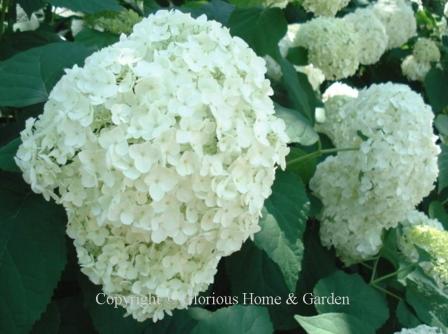 Hydrangea arborescens 'Annabelle'
Hydrangea arborescens 'Annabelle'Balsam’ has stronger stems and smaller flowerheads than ‘Annabelle.’
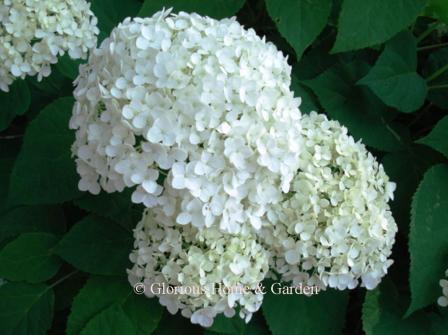 Hydrangea arborescens 'Balsam'
Hydrangea arborescens 'Balsam'Hayes Starburst’ is a lovely double flowered form.
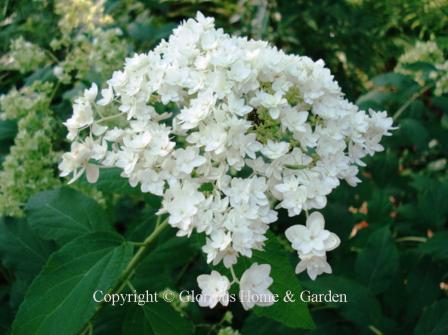 Hydrangea arborescens 'Hayes Starburst'
Hydrangea arborescens 'Hayes Starburst''White Dome®,’ also known as ‘Dardom,’ is a lacecap type of H. arborescens. It is similar to the species, but has a smaller growth habit and larger flowers. Pollinators absolutely adore it.
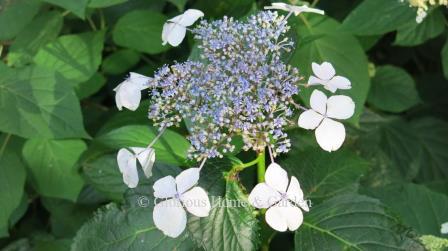 Hydrangea arborescens 'White Dome®
Hydrangea arborescens 'White Dome®Hydrangea macrophylla
Hydrangea macrophylla, bigleaf or French hydrangea, Zones 6-9. These are what most people think of when they picture hydrangeas, big puffy balls of white, blue, pink or lavender. They are quite tolerant of salty air and do very well on the seacoast. There are two big categories of H. macrophylla that look quite different--mopheads (also called hortensias) and lacecaps. Best in shady or partly shady locations, but grow extravagantly in full sun in coastal areas.
Part of the fun of growing these hydrangeas is the ability to change the flower color. Blue is determined by the availability of aluminum in acid (low pH) or alkaline (high pH) soils. Aluminum is more soluble (and thus more available to the plant) in acidic soils producing blue flowers. Aluminum is not as soluble in alkaline soils, resulting in pink flowers. Having your soil tested for pH is a great way to learn how to treat your soil if you are serious about growing hydrangeas and want specific results. Based on the test results, if the soil is too alkaline you can add aluminum sulfate to lower the pH; and if the soil is too acidic and you prefer pink flowers, you can add lime to raise the pH.
Pruning H. macrophylla: The important thing to remember about pruning these hydrangeas is that they bloom on new wood. They set the next year’s flower buds by the end of summer, so if you prune them in fall or winter (other than trimming off dead flower heads) you will lose your flowers for a year. The time to prune them is after they bloom in mid-summer—probably no later than early August.
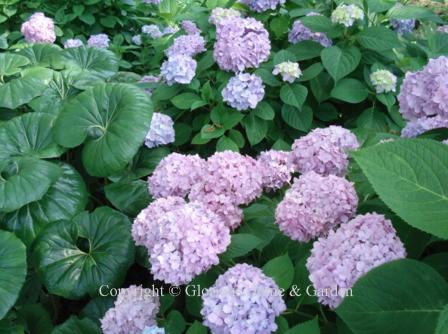 Hydrangea macrophylla
Hydrangea macrophyllaMopheads
Mopheads form balls of tightly packed florets, that are actually sepals. The true flowers are tiny and clustered in the center.
'Ayesha’ has in-curved cup-shaped sepals that give it a different appearance from other mopheads—it also has a slight fragrance. Zones 6-9.
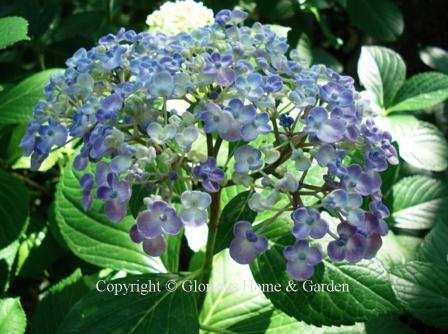 Hydrangea macrophylla 'Ayesha'
Hydrangea macrophylla 'Ayesha''Dooley' is a classic mophead named for former University of Georgia football coach Vince Dooley, who is quite an avid gardener. ‘Dooley’ is a heavy bloomer and can reach 3 to 6’ with equal spread. Prune only just after flowering to prevent loss of next year's blooms.
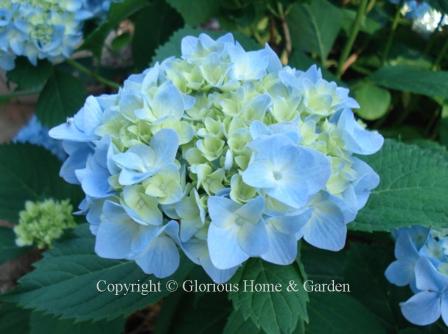 Hydrangea macrophylla 'Dooley'
Hydrangea macrophylla 'Dooley'‘Doublicious’ is a double form macrophylla mophead that is gorgeous in the garden. I first saw it at the Atlanta Botanical Garden-Gainesville, and fell in love. The color is variable depending on soil pH, and the flowers fade beautifully as they mature. It blooms on old wood in late spring/early summer, and again on new wood in late summer into fall.
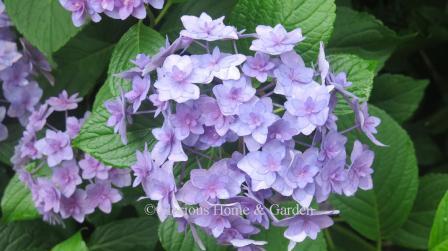 Hydrangea macrophylla 'Doublicious'
Hydrangea macrophylla 'Doublicious'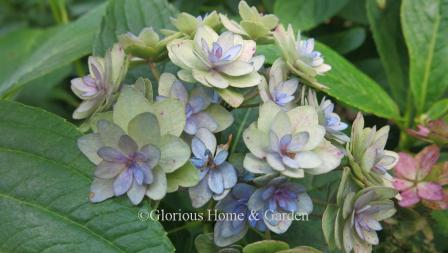 Hydrangea macrophylla 'Doublicious' showing flowers in faded stage
Hydrangea macrophylla 'Doublicious' showing flowers in faded stage‘Endless Summer’-The Original® is the one that kicked off the Endless Summer® collection of hydrangeas that was developed to bloom on old and new wood, thus extending the flowering season with repeat blooming. It also has greater cold-hardiness which is a boon to Southern gardeners who would often lose their hydrangea blooms to a late freeze that would kill the buds Zones 4-9.
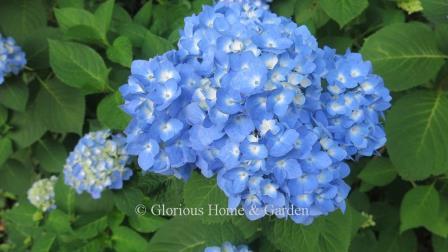
'Mme. Emile Mouillère’ is a classic white mophead with pink or blue "eyes." Zones 5-9.
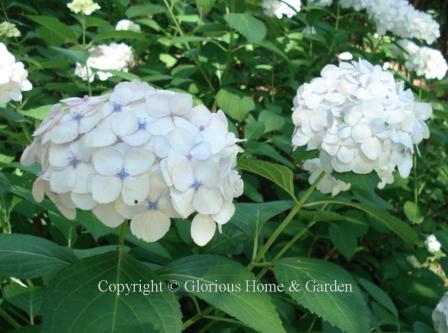 Hydrangea macrophylla 'Mme. Emile Mouillere'
Hydrangea macrophylla 'Mme. Emile Mouillere''Nigra’ produces smaller flowerheads that are set off by dark purple stems. Zones 6-9.
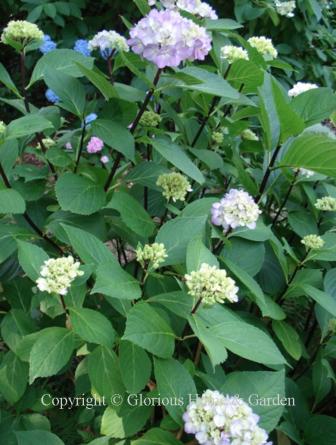 Hydrangea macrophylla 'Nigra'
Hydrangea macrophylla 'Nigra''Penny Mac’ is named for Penny McHenry, who founded the American Hydrangea Society. This classic H. macrophylla mophead is variably pink or blue depending on your soil chemistry. Zones 5-9.
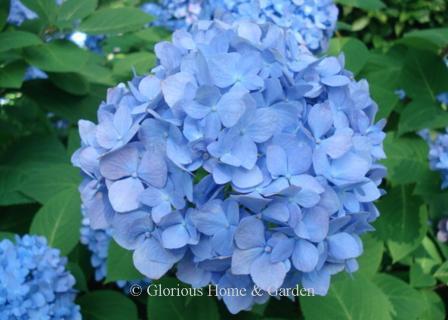 Hydrangea macrophylla 'Penny Mac'
Hydrangea macrophylla 'Penny Mac'‘Venice’ (sometimes called 'Venice Raven') is from the Cityline® Series of dwarf hydrangeas developed in Germany. The shrub can reach from 12” to 36” with an equal spread, so it is a perfect choice for a small garden or a container.
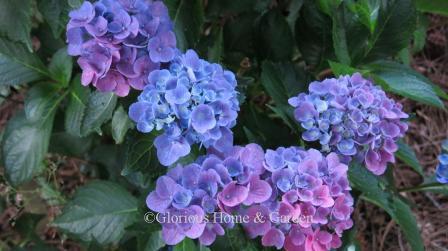 Hydrangea macrophylla 'Venice'
Hydrangea macrophylla 'Venice'Lacecaps
Lacecaps have a tight inner cluster of true flowers surrounded by the larger outer ray florets. As with the mopheads, the color is changeable depending on the aluminum availability in the soil.
‘Blue Wave,’ also known as ‘Mariesii Perfecta’ is an older lacecap cultivar, but very showy in the garden. Can be pink, lilac or blue depending on the availability of aluminum in the soil. Zones 5-9.
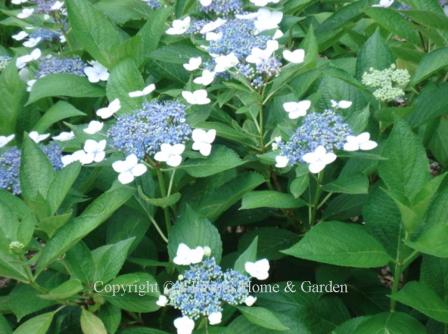 Hydrangea macrophylla 'Blue Wave'
Hydrangea macrophylla 'Blue Wave'‘Fuji Waterfall’ is a delightful lacecap with double ray florets that open white maturing with a touch of blush or blue depending on soil pH. The blooms have long pinkish pedicels that arch over giving the waterfall effect. The central complete flowers are also double. Rich, dark green leaves set off the blooms beautifully and often turn red in the fall. Also known as -Fuji -no-taki,' or 'Sumida-no-hanabi’ Zones 5-9.
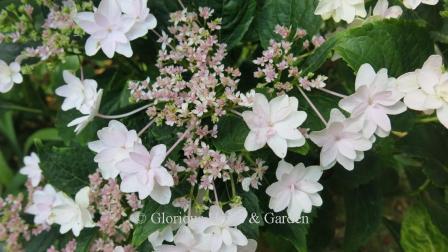 Hydrangea macrophylla 'Fuji Waterfall'
Hydrangea macrophylla 'Fuji Waterfall'‘Mariesii Variegata.’ Shrubs with variegated foliage bring light to the shade garden, and this lacecap is particularly desirable for that purpose, especially with its pink or blue flowers. Zones 6-9.
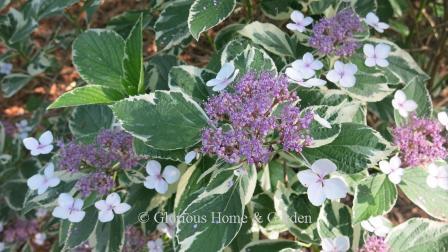 Hydrangea macrophylla 'Mariesii Variegata'
Hydrangea macrophylla 'Mariesii Variegata''Sea Gull' (‘Mowe’) also known as ‘Geoffrey Chadbund’ is a Swiss cultivar with unusually large flowerheads that are very striking in the garden. Zones 6-9.
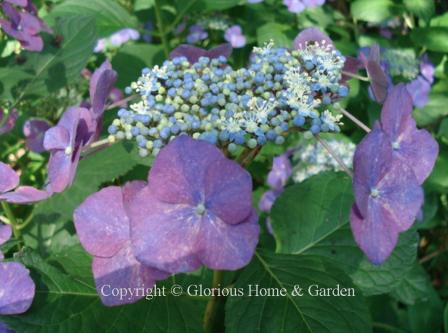 Hydrangea macrophylla 'Sea Gull'
Hydrangea macrophylla 'Sea Gull'‘Star Gazer,’ from the Double Delights™ series, is a most unusual lacecap cultivar. The large outer florets are double, and the centers are either pink, lavender, or blue, depending on the soil pH, and give a star-like effect. Outstanding! Zones 6-9.
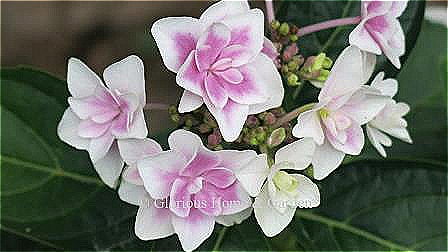 Hydrangea macrophylla Double Delights™ 'Star Gazer'
Hydrangea macrophylla Double Delights™ 'Star Gazer'‘Star Gazer,’ from the Double Delights™ series, showing how the pH of the soil can effect the color of the blooms. Acidic soils makes the blooms lavender or blue, alkaline soil turns them pink.
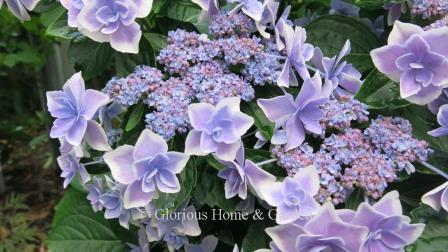 Hydrangea macrophylla Double Delights™ 'Star Gazer'
Hydrangea macrophylla Double Delights™ 'Star Gazer''Twist-n- Shout®,’ part of the 'Endless Summer® series, is a fantastic lacecap that reblooms all summer--in fact, this one was still blooming in October at the Coastal Maine Botanical Gardens! Blossom heads can be blue or pink depending on your soil. Zones 4-9.
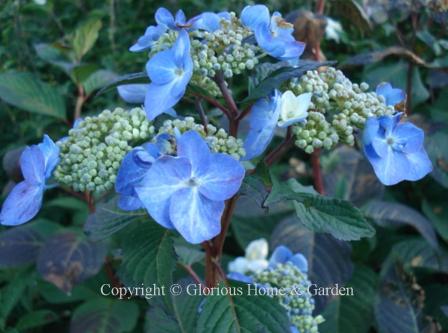 Hydrangea macrophylla Endless Summer Twist n Shout'
Hydrangea macrophylla Endless Summer Twist n Shout'‘Veitchii’ is a lacecap that is ringed with white ray florets. Zones 6-9.
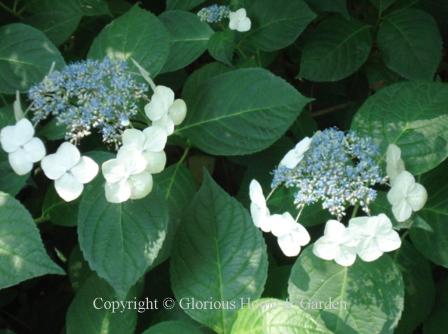 Hydrangea macrophylla 'Veitchii'
Hydrangea macrophylla 'Veitchii'‘Wedding Gown’ from the Double Delights™ series, (also known as ‘Dancing Snow’) is a lacecap cultivar with large double florets in white surrounding the center true flowers. ‘Wedding Gown’ produces flowers on both old and new wood—the first flush opening from buds formed the previous year, and later blooms from buds formed on new growth. Zones 5-9.
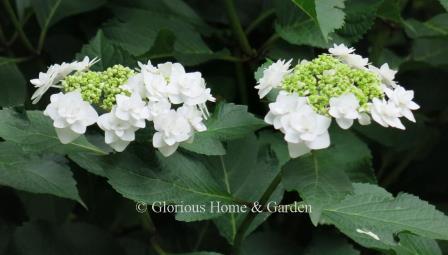 Hydrangea macrophylla Double Delights™ 'Wedding Gown'
Hydrangea macrophylla Double Delights™ 'Wedding Gown'Hydrangea paniculata
Hydrangea paniculata, or panicle hydrangea, extends the hydrangea season by blooming later in the summer after H. macrophylla, and it is also more cold tolerant. The flowerhead is an elongated panicle that often turns lovely shades of pink, rose or red as they mature. H. paniculata blooms on the current season’s growth, so it can be pruned in late winter to early spring without loss of bloom.
'Burgundy Lace’ opens white and ages to pink and then violet. Zones 3-9.
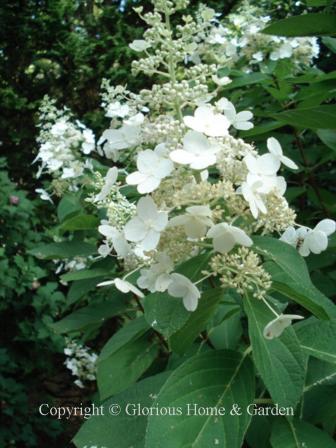 Hydrangea paniculata 'Burgundy Lace'
Hydrangea paniculata 'Burgundy Lace'Fire Light®’ is a lovely, fast-growing cultivar from Proven Winners that can reach 4 ½ to 6’ in height. The large white trusses of blooms appear all summer into fall and turn lovely shades of pink to raspberry-red as they mature (especially in cooler weather). Zones 3-8.
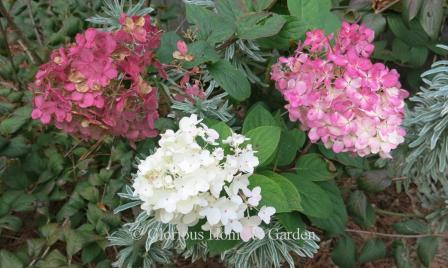 Hydrangea paniculata 'Fire Light'
Hydrangea paniculata 'Fire Light''Limelight’ is a very exciting cultivar that really skyrocketed the popularity of the paniculatas. Large upright panicles open lime green and mature to white and then to pink. Zones 4-8.
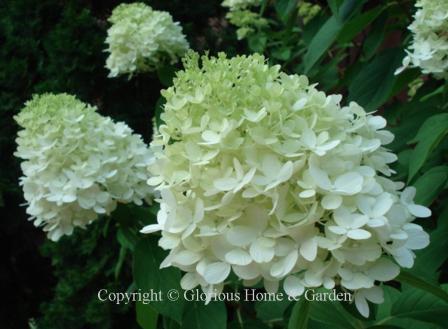 Hydrangea paniculata 'Limelight'
Hydrangea paniculata 'Limelight''Little Lime®’ is a more compact version of the popular ‘Limelight.’ It grows to a 3-5’ mound with flowers that open green, then white and mature to rosy tones in fall. Other compact panicle hydranges to look for include ‘Baby Lace®,’ and ‘Bobo®.’ Zones 3-8.
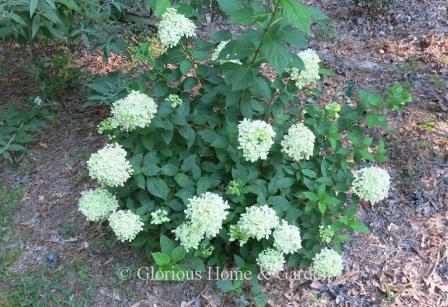 Hydrangea paniculata 'Little Lime'
Hydrangea paniculata 'Little Lime''Unique’ forms a tall shrub (to 10’ or more) or small tree with large inflorescences of white that age to pink. Zones 3-9.
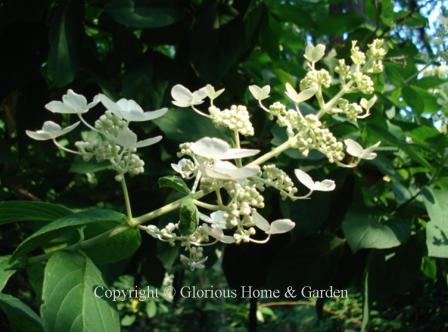 Hydrangea paniculata 'Unique'
Hydrangea paniculata 'Unique'Hydrangea quercifolia
Hydrangea quercifolia, oakleaf
hydrangea, Zones 5-9. Oakleaf hydrangea
is another of our great native species, producing large, white showy
inflorescences in summer that fade to pink and finally brown. Oakleaf hydrangea is especially nice in a woodland
setting in partial shade, though it will grow in full sun. It appreciates humus-rich soil, good drainage
and moist, but not soggy soil.
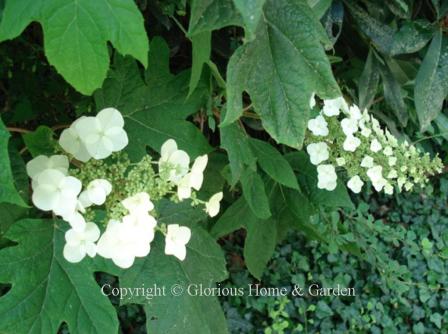 Hydrangea quercifolia
Hydrangea quercifolia'Emerald Lake’ has denser flowerheads than the species. Zones 5-9.
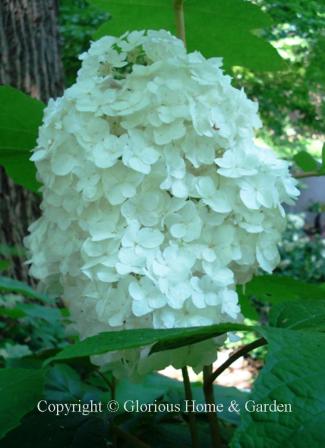 Hydrangea quercifolia 'Emerald Lake'
Hydrangea quercifolia 'Emerald Lake''Little Honey’ has unique golden foliage (best planted where it will get afternoon shade), white flowers, and crimson fall color. Wonderful to brighten a dark corner, but the foliage color is brighter in full sun.
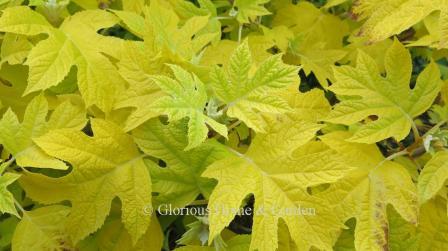 Hydrangea quercifolia 'Little Honey'
Hydrangea quercifolia 'Little Honey'‘Ruby Slippers’ with white flowers that turn to soft pink and then deep ruby red as they mature on a compact plant of about 3-4’.
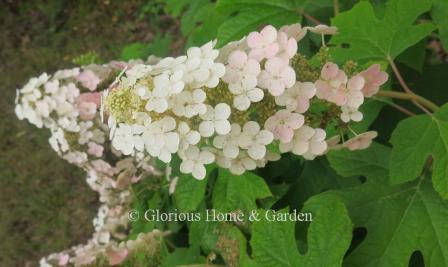 Hydrangea quercifolia 'Ruby Slippers'
Hydrangea quercifolia 'Ruby Slippers'‘Snowflake’ is a double-flowered oakleaf hydrangea—actually multiple layers of sepals, creating a wonderful garden effect.
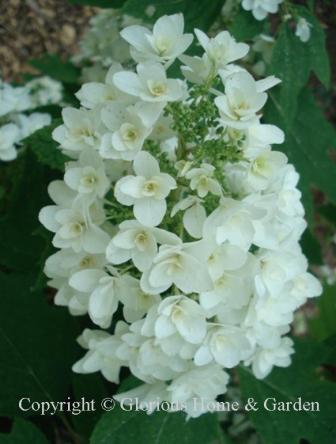 Hydrangea quercifolia 'Snowflake'
Hydrangea quercifolia 'Snowflake'Hydrangea serrata
Hydrangea serrata, mountain hydrangea, is a species from Japan and Korea with a delicate, appearance on a smaller plant than H. macrophylla. In fact, experts consider H. serrata a subspecies of H. macrophylla as they share many of the same characteristics and requirements. There are both mophead and lacecap types, though lacecaps seem to predominate, they can be blue or pink depending on the soil pH, and they both bloom on new wood, so should not be pruned until after flowering. Regardless of their classification, they are lovely plants and suit some situations better than their larger cousins.
‘Bluebird’ has a ring of larger sterile florets surrounding the true flowers in blue in the center. This one blooms on old wood, so it should be pruned immediately after flowering if needed. As a bonus, the leaves turn brilliant colors of red in the fall. Zones 5-9.
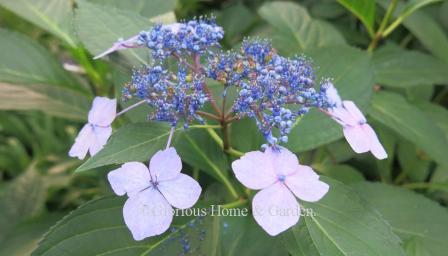 Hydrangea serrata 'Bluebird'
Hydrangea serrata 'Bluebird''Blue Deckle’ is a lacecap that reblooms in the late summer to early fall. Very hardy cultivar that blooms on new growth. Zones 6-9.
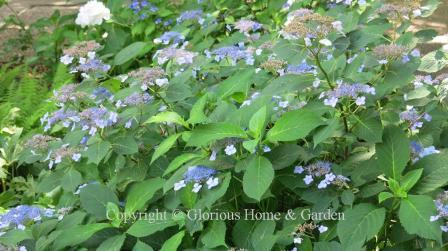 Hydrangea serrata 'Blue Deckle'
Hydrangea serrata 'Blue Deckle'‘Gotemba Nishiki,’ (‘Euphoria Pink’), won second place in the 2023 Chelsea Flower Show as Plant of the Year and deservedly so. This exciting new introduction from Japan has bright pink lacecap flowers with lighter centers and lovely variegated foliage of green, white and a bit of blush pink. The compact size of about 24” high and wide, makes it perfect for smaller spaces. It seems to be exclusively available in the U.K. at the moment, but hopefully it will be made available in the U.S. soon.
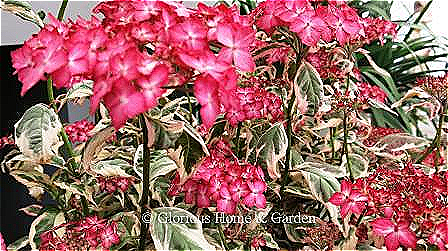 Hydrangea serrata 'Gotemba Nishiki'
Hydrangea serrata 'Gotemba Nishiki'‘Kokonoe-yama’ has many outstanding qualities including its petite stature of about 2-3’ making it a good choice for small spaces. But its delicate appearance and especially its foliage flecked with light streaks and spots giving it a sugar frosted look make it special. Zones 6-9.
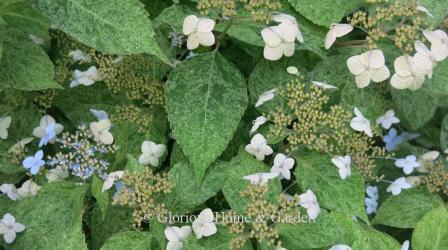 Hydrangea serrata 'Kokonoe-yama'
Hydrangea serrata 'Kokonoe-yama''Miyama-yae-murasaki’ is a lacecap type with double ray florets of lilac or blue encircling the central fertile flowers. Zones 6-9.
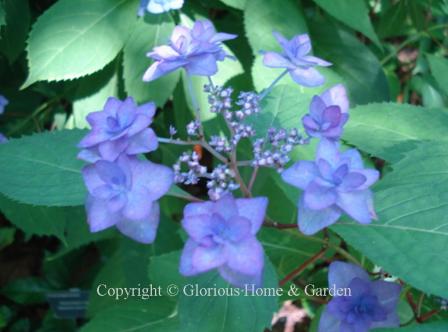 Hydrangea serrata 'Miyama-yae-murasaki'
Hydrangea serrata 'Miyama-yae-murasaki'Plant of the Month
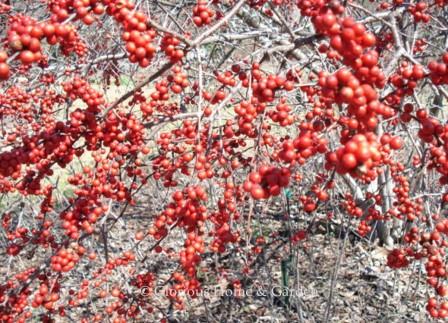
Ilex verticillata
Winterberry holly
Updated new USDA Plant Hardiness Zone Map 2023.